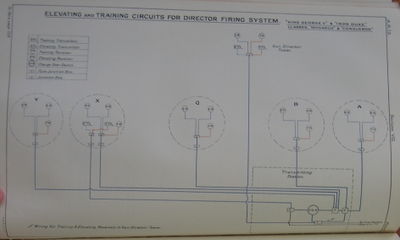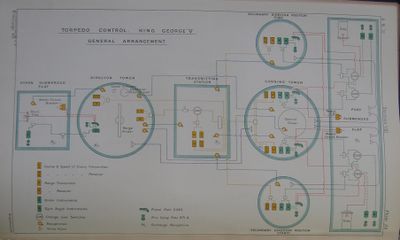Difference between revisions of "King George V Class Battleship (1911)"
m |
|||
| Line 6: | Line 6: | ||
The broadside tubes forward were depressed 2 degrees and were 14 feet, 1.8125 inches below load waterline with the tube axis 2 feet, 1.1875 inches above the deck. The stern tube was depressed 1 degree and was 8.5 feet below load WL with its axis 1 foot, 8.625 inches above the deck.<ref>''Addenda (1911) to Torpedo Manual, Vol. III., 1909'', p. 155.</ref> | The broadside tubes forward were depressed 2 degrees and were 14 feet, 1.8125 inches below load waterline with the tube axis 2 feet, 1.1875 inches above the deck. The stern tube was depressed 1 degree and was 8.5 feet below load WL with its axis 1 foot, 8.625 inches above the deck.<ref>''Addenda (1911) to Torpedo Manual, Vol. III., 1909'', p. 155.</ref> | ||
| + | |||
| + | The stern tubes were probably removed sometime during or after 1916.<ref> ''Annual Report of the Torpedo School, 1916'', p. 36. (T.O. 168/1916)</ref> | ||
==Fire Control== | ==Fire Control== | ||
Revision as of 20:51, 8 May 2011
Armament
Guns
Torpedoes
The ships had three submerged 21-in tubes. The broadside tubes bore 10 degrees before the beam.[1]
The broadside tubes forward were depressed 2 degrees and were 14 feet, 1.8125 inches below load waterline with the tube axis 2 feet, 1.1875 inches above the deck. The stern tube was depressed 1 degree and was 8.5 feet below load WL with its axis 1 foot, 8.625 inches above the deck.[2]
The stern tubes were probably removed sometime during or after 1916.[3]
Fire Control
Rangefinders
The rangefinder in the TCT was a initially a 9-foot F.T. 24 on an M.Q. 10 mounting.[4][5][6]
Sometime, likely not before 1918, these were to be upgraded to 15-foot instruments, probably also F.T. 24, with new armoured hoods and racers and training driving the hood directly rather than through the rangefinder mounting. These rangefinders lacked hand-following gear to facilitate in transmission of range cuts, and when it was considered as an addition around 1917, space concerns were causing issues.1[7]
By 1918, the desire for torpedo control rangefinders was so keen that the ships were told to save their 9-foot instruments upon receipt of their 15-foot models, as new mountings would be sent so that the 9-foot instrument could be mounted elsewhere.[8]
Evershed Bearing Indicators
All 4 units were likely fitted with this equipment before late 1914.[10] [11]
The transmitting positions were
- Conning Tower (periscope transmitters adapted to receive to port and starboard with C.O.S. to select one in use)
- Gun Control tower (rangefinder transmitter fitted to Argo rangefinder)
- 'B' turret
- 'X' turret
The receiving positions were
- all 5 turrets had both an open-face and a turret trainer's indicator
- the periscopes in the CT each had an open-face indicator. The one selected on the local COS would indicate the received bearing
- the GCT had an open-face indicator
The protocols for handling wooding of the turrets is outlined in the Handbook for Fire Control Instruments, 1914.[12]
Mechanical Aid-to-Spotter
At some point, all ships were equipped with two Mark I Mechanical Aid-to-Spotters, one on each side of the foretop, keyed off the Evershed rack on the director. As the need for such gear was apparently first identified in early 1916, it seems likely that these installations were effected well after Jutland.[13]
Gunnery Control
The control arrangements were as follows.[14]
Control Positions
- Gunnery control tower
- 'B' turret
- 'X' turret
Some ships had C.O.S.s within the control positions so they could be connected to either TS.[15]
Control Groups
The five 13.5-in turrets were each a separate group with a local C.O.S.[Inference] so that it could be connected to
- Forward TS
- After TS
- Local control from officer's position within turret
Directors
Main Battery
The ships were fitted with a cam-type tripod-type director in a light aloft tower on the foremast along with a directing gun in 'X' turret.[16]
The main battery could be divided into forward ('A', 'B' & 'Q') and aft ('X' & 'Y') groups for split director control.[17]
A C.O.S. in the TS afforded these options:[18]
- All turrets on aloft tower
- All turrets on directing gun
- Forward group on aloft tower, aft group on directing gun
Secondary Battery
The 4-in guns never had directors installed.[19]
Torpedo Control
By late 1915, Centurion was fitted with a Torpedo Control Plotting Instrument Mark I in the TCT.[22] King George V and Ajax were fitted some time before mid 1917.[23] It is unlikely that Audacious ever received such equipment.[Inference]
Between late 1915 and mid 1917, the remaining ships in the class were provided a Torpedo Bearing Plotting Instrument Mark I in the TCT.[24]
The ships had small armoured hoods fitted and enjoyed frontal protection from the ship's side armour. A 4-inch embrasure as drawn here gave a line of sight from 70 degrees before to 80 degrees abaft the line of the tube, but this was later modified before construction to do 80 degrees on either side of the tube. Hinged shutters allowed the embrasure to be closed when not in use, and the stand for the director could be swiveled to match any gyro angle in use at the tube.[25]
The Torpedo Control Tower had a rangefinder with object glasses in an armoured hood which was dedicated to torpedo control (G. 0639/12). The tower also had a Forbes Speed Indicator. From 1913, it was planned to also equip it with a deflection plotting system of indeterminate type as there was no yet a proven system to choose.
The TCT was to use its own equipment to determine the range, course and speed (or deflection) of the enemy and then to transmit it to all torpedo positions by Barr and Stroud instruments. A C.O.S. in the Transmitting Station permits its transmitters, rather than the TCT's to supply this data.
The broadside tubes could be fired either from the Conning Tower or from secondary torpedo control positions in armoured hoods on the beam, situated directly over the broadside tube. The tubes received gyro angles and orders from either the CT or their secondary control position, as determined by C.O.S.es in the torpedo flat. The stern tube could only be fired from the TCT, and so had no C.O.S.
The broadside tubes had voicepipes to both the CT and to their secondary control position. A navyphone with a special transmitter connected the TCT to the stern tube.
The TS had 4 navyphone connections to the CT, the TCT and to the two secondary torpedo control positions at port and starboard. The TCT had a voicepipe as well as a navyphone connecting it to the CT and a navyphone to the Fun Control Tower. Additionally, navyphones at the ship's exchange could be used as alternatives to the hard-wired network.[26]
In all, the system is a condemning illustration of the Royal Navy's absurd over-emphasis on torpedo armaments in their capital ships. At most, one could expect a single torpedo tube to be pointing toward an enemy, and we see the context created to realize its puny threat if we count up the hardware that would have no use without the torpedo outfit remained in place:
- 3 torpedo tubes and stocks of torpedoes
- 2 floodable spaces, one large and transverse
- 2 dedicated director positions
- 12 dedicated navyphones
- 2 exchange navyphones
- 5 triggers
- 6 C.O.S.
- 1 Forbes speed indicator
- 10 gongs
- 3 circuit breakers
- 4 voice pipes
- 8 orders instruments
- 6 gyro angle instruments
- 8 course and speed instruments
- 8 range instruments
- personnel to maintain and serve this equipment
- space taken up in Conning Tower and Transmitting Station
Transmitting Stations
These ships discarded the second TS found in earlier dreadnoughts and relied on a single TS.[27]
Dreyer Table
King George V had a Mark III Dreyer Table while the other three units received Mark II Dreyer Tables.[28][29] As of June 1918, they had not been provided Dreyer Turret Control Tables.[30]
Fire Control Instruments
Continuing the pattern established in the Colossus class, all 4 units used Vickers F.T.P. Mark III range and deflection instruments to the gun sights and Barr and Stroud (probably Mark II*[Inference]) instruments for other purposes.[31]
The ships had Gun Ready signals in the TS and control positions, but were the first dreadnoughts to discontinue the use of Target Visible signals that appeared in earlier classes.[32]
See Also
Footnotes
- ↑ Annual Report of the Torpedo School, 1918, p. 51.
- ↑ Addenda (1911) to Torpedo Manual, Vol. III., 1909, p. 155.
- ↑ Annual Report of the Torpedo School, 1916, p. 36. (T.O. 168/1916)
- ↑ Annual Report of the Torpedo School, 1917, p. 198.
- ↑ Annual Report of the Torpedo School, 1918, p. 175.
- ↑ Inferences M.Q. 10 and F.T. 24
- ↑ Annual Report of the Torpedo School, 1917, p. 198. (C.I.O. 481/17)
- ↑ Annual Report of the Torpedo School, 1918, p. 177. (C.I.O. 5787/18)
- ↑ Handbook for Fire Control Instruments, 1914, Plate 46.
- ↑ Handbook for Fire Control Instruments, 1914, p. 36.
- ↑ Handbook for Fire Control Instruments, 1914, Plate 46.
- ↑ Handbook for Fire Control Instruments, 1914, p. 38.
- ↑ The Technical History and Index: Fire Control in HM Ships, 1919, pp. 25-6.
- ↑ Handbook for Fire Control Instruments, 1914, p. 7.
- ↑ Handbook for Fire Control Instruments, 1914, p. 7.
- ↑ The Director Firing Handbook, 1917. pp. 88, 142.
- ↑ The Director Firing Handbook, 1917, p. 88.
- ↑ The Director Firing Handbook, 1917. p. 88.
- ↑ absent from list in The Director Firing Handbook, 1917. pp. 143.
- ↑ Annual Report of the Torpedo School, 1911, Plate 14.
- ↑ The Annual Report of the Torpedo School, 1915, p. 30.
- ↑ Handbook of Torpedo Control, 1916, p. 38.
- ↑ Handbook of Torpedo Control, 1916, p. 38.
- ↑ Handbook of Torpedo Control, 1916, p. 38. Inference based on Mark II gear being in place in other ships in 1915.
- ↑ Annual Report of the Torpedo School, 1911, p. 43.
- ↑ Annual Report of the Torpedo School, 1912, p. 63.
- ↑ Handbook for Fire Control Instruments, 1914, pp. 6-7.
- ↑ Handbook of Capt. F.C. Dreyer's Fire Control Tables, p. 3.
- ↑ Brooks, John. Dreadnought Gunnery and the Battle of Jutland, p. 166.
- ↑ absent from list in Handbook of Capt. F.C. Dreyer's Fire Control Tables, p. 3.
- ↑ Handbook for Fire Control Instruments, 1914, pp. 72.
- ↑ Handbook for Fire Control Instruments, 1914, p. 11.
Bibliography
- Template:BibUKARTS1912
- Template:BibUKFireControlInHMShips1919
- Admiralty, Gunnery Branch (1914). Handbook for Fire Control Instruments, 1914. G. 01627/14. C.B. 1030. Copy 1235 at The National Archives. ADM 186/191.
- Template:BibBrooksDreadnoughtGunnery
- Template:BibUKDirectorFiringHandbook1917
- Template:BibUKDreyerTableHandbook1918



